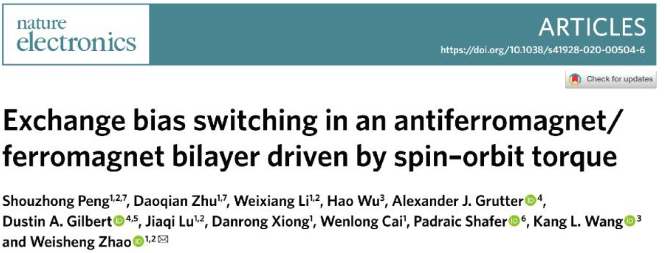On November 30, the research group led by Zhao Weisheng from the School of Integrated Circuit Science and Engineering published their research results entitled “Exchange bias switching in an antiferromagnet/ferromagnet bilayer driven by spin-orbit torque” in Nature Electronics. In their research, the spin-orbit torque (SOT) is used to achieve the exchange bias switching in an antiferromagnet/ferromagnet bilayer. The team also uses X-ray magnetic circular dichroism, polarized neutron reflectometry measurements and micromagnetic simulations to reveal relative physical mechanisms, which offers new insight into the exchange bias switching as well as the development of next generation of spintronic devices.

The joint first authors of the research paper are Peng Shouzhong, a lecturer from the School of Integrated Circuit Science and Engineering and Zhu Daoqian, a PhD student enrolled in the 2017. The only corresponding author is Professor Zhao Weisheng and the first institute is Beihang University. Other co-authors who participated in the research include Prof. Kang L. Wang and Dr. Hao Wu from the University of California, Los Angeles, Alexander J. Grutter and Dustin A. Gilbert from National Institute of Standards and Technology, and Padraic Shafer from Lawrence Berkeley National Laboratory.
In recent years, the spintronics, in particular, the branch of spin-transfer torque magnetic random-access memory (STT-MRAM) has drawn much attention of the related researchers in this field. STT-MRAM has many applications in support of the Internet of Things and wearable devices. However, it suffers from the disadvantages of limited writing speed and endurance, and cannot completely replace Static Random Access Memory (SRAM). The new writing methods based on spin–orbit torques are expected to make a breakthrough for this problem. Besides, the use of new materials such as topological materials and two-dimension materials may further reduce power consumption, which marks an important research direction in this field.
The research achieves independent and repeatable switching of the magnetization and exchange bias field below the blocking temperature by manipulating the current direction and amplitude, and reveals the mechanism of electrical manipulation of magnetization and exchange bias in antiferromagnet/ferromagnet thin films, which is effective in improving data storage density and reducing power consumption during data writing.

The switching process of spin–orbit torques in IrMn/CoFeB structures

The simulation results
The research was supported by the National Science Foundation of China, Program of Introducing Talents of Discipline to Universities, the National Key Technology Program of China, the Research Projects of Hefei Innovation Research Institute of Beihang University and so on.
The research article can be referred to at:
https://www.nature.com/articles/s41928-020-00504-6
Reported by Peng Shouzhong
Edited by Jia Aiping
Reviewed by Liang Enhe
Translated by Xiong Ting

